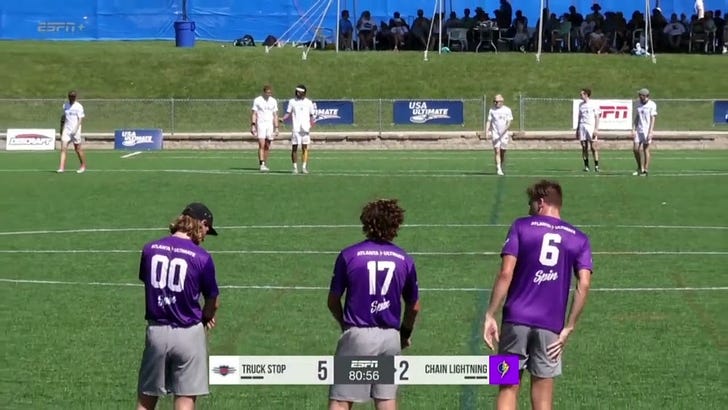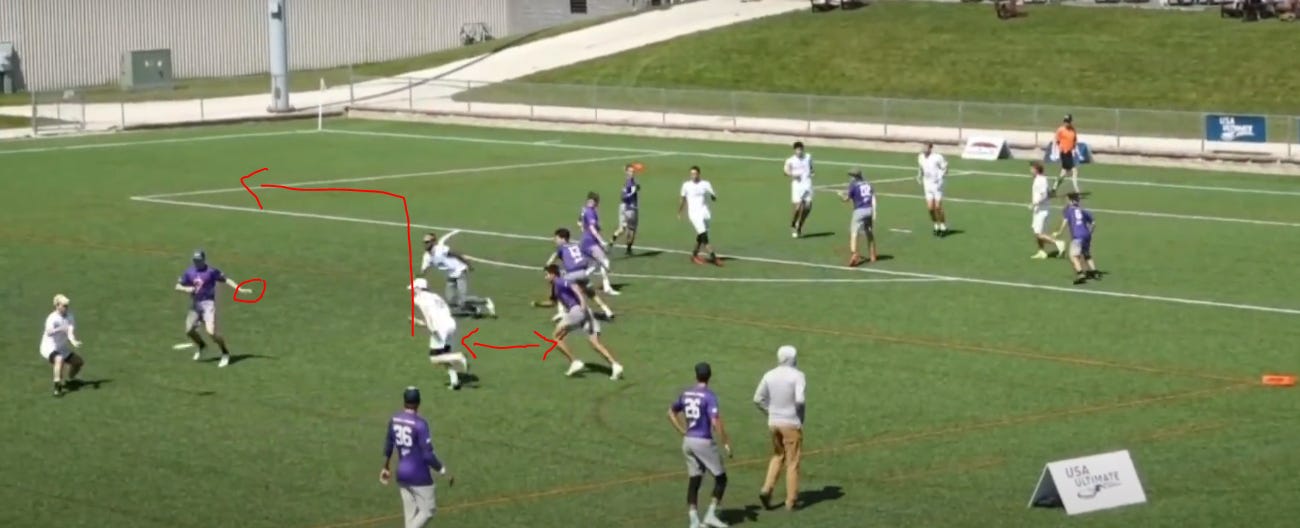PS: Come join the bettereveryday coaching discord if you want to discuss any of these further with coaches and players from around the world. Invite link: https://discord.gg/BDqnwpqM
Changing Defences based on the game situation
I only watched a small bit of the Pro Championships last weekend, but I saw enough to gather that it was extremely warm. Warm conditions definitely change my gameplans, particularly because I’ve always played with a fairly tight offence line so the health and energy levels of players becomes an issue*.
This is from the Open final. To put the game situation in perspective, Chain (in purple) have just held their offence but in a very lengthy point. They’re a break down but it’s early days. Watch the next two points:
It’s obviously an error that allows Truck to score quickly on an early deep shot (great finishing from Ben Oort as well) but my priority calling the defence here would be - no quick scores. The O line is tired and if they have to come back out quickly - well, what happens is what I would be afraid of - the offence is tired, make an error and can’t recover.
Chain did great from here to bring the game back to level at 11-11 in the second half - but this sequence would sting for me as the coach.
The second pass give go
I’m intending to write a full detailed look at this, but I saw a couple of opposing examples while watching last weekend so wanted to share them here.
The second pass give go is something I used a lot as a player - I loooved throwing backhands and running around - and something I’ve tried to pass on a bit without great success. I’ve found it hard to have the time to really teach it properly.
But the concept is simple. You’re throwing an open pass and leveraging the exact same advantage as with a regular throw and go - you have a free step over your defender to get the disc back moving forward in a powerful position. The only difference is that rather than using the open player for a wall pass and getting the return from them, is that you are cutting to get it from the person they are going to throw to - hence the second pass name.
Here’s an example of Revolver using it in the redzone - looking at the movement of #75 Anton Orme as he throws a reset then cuts all the way across the pitch.
Now: this is obviously situational, and it’s most useful in scenarios like this where you’re moving from one sideline third to another**. You also need to see two open throws and space available. So there’s no doubt it’s less generally useful than a simple give-go. But if you can learn it it’s really powerful. Here’s some reasons why I like it:
a) It’s a lot less switchable than a regular give go. Most teams are pretty good now at switching to contain the 1-2. The added complexity of recognising this (vs. a clear out) and switching multiple times breaks most switching schemes. In the Revolver clip above you can see PONY easily switch all the other give-gos but not the second pass one to start.
b) It increases your margin for error. As we’ll see in the clip below, going for a regular wall pass needs an accurate throw and catch because the space available can be quite limited which also creates problem c) below. Looking to get the disc back on the second pass can mitigate some of the problems caused if the first pass isn’t accurate because…
c) It creates better movement if it doesn’t work. Again - we’ll see it in the next clip. If a give-go is blown up either from great defence or poor execution from the offence it can grind the offence to a halt. If you’re cutting over a longer distance you have more speed and space to work with to counter.
Here we are looking at a missed opportunity. Oort (#9) hasn’t thrown the initial pass well enough to make a simple give-go. However there’s probably enough time for the throw to get the disc to the cutter coming into the space. Additionally you can see the defenders already indicating a switch, further making Oort’s give go difficult. If he reads the situation and the switch he is going to get miles free on the far side of the pitch, both because of the relative momentum and body position of both players, but also because the defender is probably going to be taken by surprise at that move.
Anyway - that’s not intended to be a criticism of Truck Stop or the players involved here - they are able to figure out the space and score easily enough. I just thought it was a decent illustration of when this scenario is missed by players.
I know, more football. But there’s not that much written frisbee content!
I enjoyed reading how Cesc’s different coaches had impacted his career and the lessons from they (good or bad) that he is carrying forth into his own coaching career. Pretty much all frisbee coaching content is written from the perspective of the coach - it would be really interesting to read something similar like this from a frisbee player that’s played under a few coaches. If you think that’s you I’d be very happy to publish that here.
Some of the most interesting parts of this for me:
a) A good example of growth mindset
b) My coaching has gotten a lot better over the 15 years that I have coached. Better knowledge, better skills but just as important was figuring out my own personality and how to make that work for me. I spent too long trying to emulate other coaches, or trying to be someone that I thought players wanted me to be.
c) I could have written this word for word for Ultimate.
Developing Star Players While Keeping Everyone Involved
OK sorry - more football. But an interesting study I only became aware of recently on developing young footballers while maintaining participation levels. The full study is here while I found this article a good summation.
Although of course the resources available are on a different level the general approach was the most interesting part and is something that is applicable to the development of frisbee clubs. It’s worth reading either of the links, however, to sum up the general approach it was to prioritise equal participation and opportunity for everyone on the team no matter the skill level.
One of the striking features of the group was that there are now 5 professionals that came through that system, including Erling Braut Halaand.
I’m always happy to read things like this that support my own view - you don’t need to separate out good players from the rest immediately. You just need strong intelligent coaching.
*I’ve also coached a lot of redheads…
**if you watched the relationist video from my last short notes you may also see a similarity between the escadinha - or escalator - principle and this








